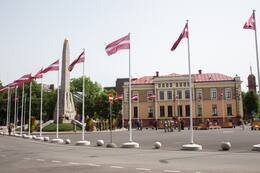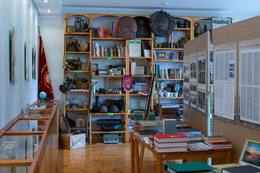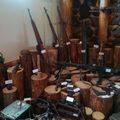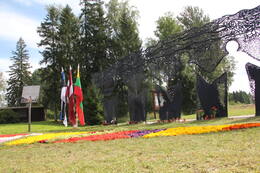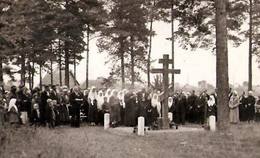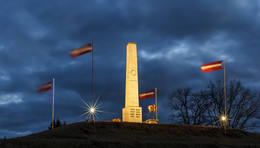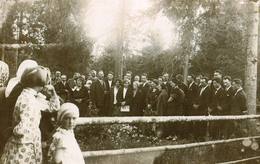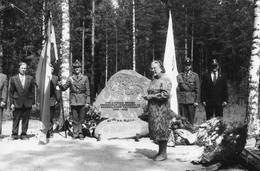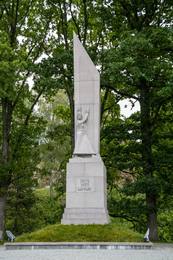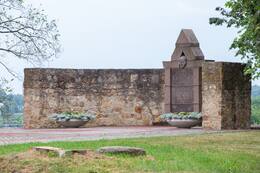Dritte Erweckung oder die singende Revolution (1987-1991)
Wiederhergestellte Unabhängigkeit, IV Sowjetische Okkupation
The Third Revival oder Singing Revolution – eine soziale Bewegung, die 1991 zur Wiederherstellung der Unabhängigkeit Lettlands führte.
Die Singende Revolution (auch das Dritte Erwachen in Lettland) war eine Periode in der Geschichte der baltischen Staaten (Lettland, Litauen, Estland) zwischen 1986 und 1991, die mit der vollständigen Wiederherstellung der nationalen Unabhängigkeit in allen drei Ländern endete. Zu Beginn der Nationalen Erweckungsbewegung, im Sommer und Herbst 1987, fanden öffentliche Proteste in dem Teil der Gesellschaft statt, die mit dem Totalitarismus der UdSSR in Lettland unzufrieden waren, was mit bedeutenden Daten in der Geschichte Lettlands zusammenfiel. Am 14. Juni 1987 organisierte die Bürgerbewegung „Helsinki-86“ eine Blumenniederlegung am Freiheitsdenkmal in Riga zum Gedenken an die Opfer der Deportationen vom Juni 1941, die die Behörden mit einem Radsportwettbewerb zu stören versuchten. Das Zentralkomitee der Lettischen Kommunistischen Partei und gehorsame Vertreter der Behörden waren auch gegen die populären Veranstaltungen vom 23. August und 18. November 1987 am Freiheitsdenkmal.
Am 1. und 2. Juni 1988 fand in Riga eine Plenarsitzung der Creative Unions statt, bei der Mavrik Wolfson, ein Kommentator der politischen Ereignisse des Kampfes und des Fernsehens, als erster öffentlich die geheimen Protokolle des Molotow-Kriegs von 1939 verlas. Ribbentrop-Pakt und Veröffentlichung der Besetzung Lettlands. Am 14. Juni fand am Haus der politischen Bildung eine Volkskundgebung und zum ersten Mal seit dem Zweiten Weltkrieg eine Prozession zum Brüderfriedhof statt, die von einer rot-weiß-roten Fahne durch Riga geführt wurde. Vom 10. bis 17. Juli fand in Riga und anderswo in Lettland das Folklorefestival BALTICA in patriotischer Stimmung statt. Am 7. Oktober fand im Mežapark eine Volksdemonstration zur Wiederherstellung der Symbole des lettischen Staates statt. Am 8. und 9. Oktober 1988 fand der erste Kongress der Lettischen Volksfront im Haus der politischen Bildung statt, wo die Publizistin Daina Īvāns zur ersten Vorsitzenden der LTF gewählt wurde.
Am 31. Mai 1989 forderte der LTF-Vorstand eine Diskussion über die vollständige Unabhängigkeit Lettlands. Am 28. Juli verabschiedete der Oberste Sowjet der LSSR eine Erklärung über die Souveränität der Lettischen SSR, in der die Gesetzgebung der Lettischen SSR der Gesetzgebung der UdSSR überlegen erklärt wurde. Am 23. August fand der Baltische Weg gegen den Ribbentrop-Molotow-Pakt und seine Folgen statt, als sich etwa zwei Millionen Menschen zusammenschlossen, um eine 670 km lange lebendige Kette zu bilden, die die baltischen Hauptstädte für mindestens 15 Minuten verband. Am 7. und 8. Oktober 1989 fand der 2. Kongress der LTF statt, der die Weichen für die Wiederherstellung der Unabhängigkeit Lettlands stellte.
Am 18. März 1990 fanden Wahlen zum Obersten Rat der Lettischen SSR statt, bei denen die von der LTF nominierten Kandidaten die größte Unterstützung erhielten. Am 4. Mai 1990 verabschiedete der Oberste Rat Lettlands die Erklärung „Über die Wiederherstellung der Unabhängigkeit der Republik Lettland“.
Aufgrund der Erschießung von Zivilisten am Fernsehgebäude in Vilnius am 13. Januar 1991 fand in Daugavmala eine lettische Nationaldemonstration statt, an der etwa 500.000 Menschen mit lettischen Nationalflaggen teilnahmen. Ab dem 13. Januar wurden an mehreren Stellen in Riga Barrikaden aus Stahlbetonblöcken errichtet, womit die Barrikadenzeit in Lettland begann. Die Zeit der Barrikaden ist ein historisches Zeichen der Verteidigungsereignisse der erneuerten Republik Lettland am 4. Mai 1990, die vom 13. bis 27. Januar 1991 in Riga und anderen Städten Lettlands organisiert wurden. Vom 19. bis 21. August 1991 übernahm das sogenannte Staatliche Notstandskomitee in Moskau die Macht. Am 21. August griffen OMON-Einheiten in der Altstadt von Riga Barrikaden in der Nähe des Saeima-Hauses an, der Oberste Rat der Republik Lettland verabschiedete eine Erklärung zur vollständigen Wiederherstellung der Verfassung der Republik Lettland und beendete den am 4. Mai 1990 postulierten Übergangszustand .
Weitere Informationsquellen
Guntis Šmidhens. Die singende Revolution. Nationale Enzyklopädie: https://enciklopedija.lv/skirklis/101078-Dziesmot%C4%81-revol%C5%ABcija
Die singende Revolution. Wikipedia. https://en.wikipedia.org/wiki/Dziesmot%C4%81_revol%C5%ABcija
Zugehörige Zeitleiste
Zugehörige Objekte
Siegesdenkmal in Cēsis
Das Siegesdenkmal für die in der Schlacht von Cēsis gefallenen Letten und Esten befindet sich in Cēsis auf dem Vienības laukums. Im Angedenken an die in der Schlacht von Cēsis (dt. Wenden) 1919 Gefallenen wurde am 22. Juni 1924 der Grundstein für das Siegesdenkmal gelegt, das vom Architekten Pauls Kundziņš entworfen, und Dank der Spendengelder der Einwohnerschaft errichtet wurde. Unter sowjetischer Besatzung wurde das Denkmal in der Nacht des 25. März 1951 gesprengt und vollständig abgerissen. Von 1959 bis 1990 stand auf dem damaligen Siegesplatz, dem vormaligen und heutigen Vienības laukums (Platz der Einheit) ein Lenin-Denkmal des Bildhauers Kārlis Jansons. 1997 gelang es dem Vorsitzenden des Bezirksrates von Cēsis, Māris Niklass, estnische staatliche Institutionen für den Wiederaufbau des Denkmals zu gewinnen. Der aus Estland gestiftete Dolomit von der Insel Saaremaa diente schließlich als Baumaterial. Am 22. Juni 1998 konnte anlässlich der Feierlichkeiten zum 79. Jahrestag der Schlacht von Cēsis auf dem Vienības laukums der Grundstein zur Wiederherstellung des Denkmals gelegt werden. Am 15. November 1998 wurde das restaurierte Siegesdenkmal eingeweiht (Architekt: Imants Timermanis). Informationen über das Siegesdenkmal finden Sie in der Ausstellung „Cēsis und der lettische Freiheitskampf“ des Stadtmuseums für Geschichte und Kunst Cēsis im Neuen Schloss.
Ständige Ausstellung der Heimatforschung in der Gemeinde Vaidava
Das Hotel liegt im Vaidava Kultur- und Handwerkszentrum.
Es gibt eine Ausstellung, die der Erinnerung an die Deportationen von 1949 sowie der Teilnahme der Rigaer an den Barrikaden im Januar 1991 in Riga gewidmet ist. In der Ausstellung sind auch Zeugnisse der Weltkriege (hauptsächlich Drucksachen) zu sehen.
Natur- und historische Gegenstände, Gutshöfe, Bildungsgeschichte, Kultur, bemerkenswerte Persönlichkeiten, Materialien aus der Kolchoszeit, Haushaltsgegenstände, Geldscheine, Zeitungen, Zeitschriften über die Gemeinde Vaidava.
Museum der nationalen Widerstandsbewegung in Renda
Das Museum liegt nur einige Kilometer vom Ortskern von Renda entfernt. Die Ausstellung ist der fünfzigjährigen Geschichte der Widerstandsbewegung in Lettland gewidmet: Widerstand gegen die erste sowjetische Besatzung, die nazideutsche Besatzung, bewaffneter und gewaltfreier Widerstand gegen die zweite sowjetische Besatzung. Die Ausstellung ist in zwei Gebäuden untergebracht. Eines birgt Zeugnisse der ersten sowjetischen und der deutschen Besatzungszeit. Die Ausstellung in der renovierten Scheune ist dem nationalen Partisanenkampf gewidmet. Zwischen den beiden Gebäuden liegt ein Bunker mit authentischer Einrichtung und Schützengräben. Das Museum umfasst auch Laufgräben, Unterstände und einen Hindernisparcours zur körperlichen Betätigung für Besucher. Ein Museumsbesuch sollte im Voraus vereinbart werden.
Im Januar 1946 fand ganz in der Nähe eine der größten Kampfhandlungen der nationalen Partisanen statt, die sog. Schlacht von Āpūznieki, in der sich die nationale Partisanentruppe von Kabile einer großen Übermacht von Kräften der sowjetischen Besatzungsmacht erfolgreich entgegenstellte. Am Schauplatz der Kämpfe wurde ein Rastplatz mit Informationstafeln angelegt.
Eine dem Baltischen Weg gewidmete Skulptur
Es befindet sich am Grenzpunkt Unguriņu-Lilli zwischen Lettland und Estland.
Im Frühjahr 2009 schuf die Gemeinde Ķonu, deren Territorium an Estland grenzt, in Zusammenarbeit mit dem Metallkünstler Andris Dukura eine Skulptur, die dem 20-jährigen Jubiläum der „Ostseestraße“ gewidmet ist.
Eine neun Meter lange und zweieinhalb Meter hohe Skulptur mit menschlichen Silhouetten, bei der man an den leeren Stellen menschlicher Silhouetten stehen und sich an den Händen halten kann. Die Idee der Skulptur erlaubt es, die Dimension der Zeit zu erweitern und nicht nur an die Kette der lebenden Menschen von 1989 zu erinnern, sondern gibt auch die Möglichkeit, in jedem Moment zusammen mit der Skulptur ein Teil der „Ostseestraße“ zu werden.
Video über die Herstellung der Skulptur.
Der Baltische Weg war eine einzigartige Kampagne, nicht nur im Baltikum, sondern in ganz Europa und sogar der Welt. Noch nie war es vorgekommen, dass sich die Bewohner dreier Länder zu einer lebendigen Teilnehmerkette zusammenschlossen, die die Hauptstädte der Länder – Vilnius, Riga und Tallinn – verband. Das historische Ereignis fand am Abend des 23. August 1989 statt und vereinte etwa 2 Millionen Menschen. Es sollte auf 50 Jahre alte Ereignisse - den Abschluss des Ribbentrop-Molotow-Pakts - aufmerksam machen und daran erinnern. Infolgedessen verteilten die beiden damaligen Supermächte - Deutschland und die UdSSR - die Einflusssphären in Europa vor dem nächsten Weltkrieg neu, aber die baltischen Staaten verloren ihre Unabhängigkeit.
Die rund 600 km lange Teilnehmerkette in Lettland markierte die Baltische Straße von Bauska nach Riga, weiter nach Sigulda, Cēsis, Valmiera und Rūjiena.
Denkmal für Soldaten - Altgläubige, die für die Befreiung Lettlands starben
Befindet sich auf dem Friedhof der Stadt Jēkabpils.
Das von der Gemeinde der Altgläubigen errichtete Denkmal für die Soldaten – Altgläubige, die für die Befreiung Lettlands in den Jahren 1918-1919 starben, kann besichtigt werden.
Die Gemeinschaft der Altgläubigen umfasste mehrere Familien, deren Vertreter an den Kämpfen von 1918-1919 teilgenommen hatten, als die Frage der Erlangung der Unabhängigkeit Lettlands gelöst wurde. Nach dem Freiheitskampf erhielten diese Soldaten Grundstücke aus dem Free Land Fund. Zum Beispiel für den lettischen Armeeoffizier Nikolaj Lebedev. 1935 wurde auf Anregung der Lehrerin Tarasija Makarova (1880 - 1953), der Vorsitzenden der Gemeinde der Altgläubigen, beschlossen, ein Denkmal für die Kämpfer für die Unabhängigkeit Lettlands zu errichten. Auf dem Stadtfriedhof Jēkabpils wurde auf einer gerodeten und geschotterten Fläche, die mit weiß getünchten Pfosten eingezäunt war, unter einer Kiefer ein fast drei Meter hohes Eichenkreuz aufgestellt. Altgläubige Zimmerleute verarbeiteten das Holz und schufen ein beeindruckendes achtzackiges Kreuz. Traditionsgemäß wurde die erklärende Inschrift auf einer separaten Eichentafel am Fuß des Kreuzes angebracht. In Jēkabpils, in der Möbelwerkstatt von V. Lukomskas, wurde eine Inschrift in russischer Sprache geschnitzt: "Für Soldaten - alte Gläubige, die für die Befreiung Lettlands gefallen sind." Gott, gib ihnen ewige Erinnerung!“ Ursprünglich gab es in der Nähe des erwähnten Kreuzes keine Bestattungen - nur einen Kiefernwald. 20. Jahrhundert In den 1950er Jahren war das Kreuz veraltet. Der damalige Vorsitzende der Gemeinde der Altgläubigen, Vasilijs Jakovlevich Fedotovs, 20. Jahrhundert. Mitte der 1960er Jahre erhielt er die Erlaubnis, das Denkmal zu restaurieren, nur unter der Bedingung, dass das Denkmal nicht die Form eines Kreuzes und die Aufschrift „Für die Befreiung des Vaterlandes“ haben sollte.
Die Restaurierung des Denkmals wurde A. Blumberg anvertraut. Er polierte einen großen braunen Steinblock zu einer rechteckigen Gedenkstele und schnitzte ein achteckiges Kreuz und Eichenzweige in die Vorderwand. Unter den Worten: „Ewige Erinnerung an die Befreiung des Vaterlandes für die gefallenen Soldaten“ wurde in viel kleineren Buchstaben die Inschrift „Gemeinde der Altgläubigen von Jēkabpils“ eingemeißelt. Das Denkmal wurde auf einem massiven Betonfundament errichtet. Andererseits wurde die frühere Eichentafel mit der Inschrift geschützt, indem sie in der Kirche angebracht wurde.
Denn zu Beginn des Dritten Erwachens war in Jēkabpils kein anderes Denkmal im Zusammenhang mit der Proklamation des lettischen Staates erhalten geblieben. Deshalb hielten die Einwohner von Jēkabpil bereits am 18. November 1988 auf dem Friedhof der Altgläubigen in der Nähe des Denkmals für die in den lettischen Freiheitskriegen gefallenen Soldaten eine Gedenkfeier mit Blumen und Kerzen ab. Bald kehrte die restaurierte Eichentafel zum Fuß des Denkmals zurück. Die Eichentafel wurde bald durch eine Marmortafel mit einer identischen Reproduktion der ursprünglichen Inschrift ersetzt. Im Jahr 2013 wurde das Denkmal auf Initiative des Vereins Belovodije und seines Projekts restauriert und gereinigt.
Denkmal für die Soldaten des 7. Sigulda-Infanterie-Regiments, die im lettischen Unabhängigkeitskrieg starben
Das Hotel liegt am Ufer des Alūksne-Sees, am Rand der Pleskavas-Straße (Kolberg-Straße).
Am 22. Juni 1923 enthüllte der lettische Präsident Jānis Čakste ein Denkmal für die gefallenen Soldaten des 7. Sigulda-Infanterie-Regiments. Das Denkmal basiert auf dem Entwurf des Künstlers Jūlijs Miesnieks.
Die Soldaten des Regiments verbesserten und pflegten auch das Gebiet um das Denkmal. Soldaten versammelten sich am Denkmal am Vorabend der jährlichen Feiertage des Regiments, wenn das heilige Feuer entzündet wurde, sowie am Tag des Regimentsjahres nach der Parade und der Fürbitte auf dem Garnisonsfriedhof.
1940/1941 Die Tafel wurde 1953 von den Bolschewiki entfernt und zerstört, aber das Denkmal selbst wurde 1953 abgerissen und seine Steine wurden in die Fundamente der Ecke des Kasernenhauses gelegt.
Zu Beginn des Erwachens, im Herbst 1989, wurde die Umgebung des zerstörten Denkmals, das sich noch auf dem Territorium der Besatzungstruppen der UdSSR befand, gesäubert. Am 11. November wurde am ehemaligen Standort des Denkmals ein provisorisches Granitdenkmal mit dem Text enthüllt: "Das Denkmal des 7. Sigulda-Infanterie-Regiments wird an dieser Stelle am 11. November 1989 wiederhergestellt."
Dank der Initiative von U. Veldre, dem Vorsitzenden des Friedhofskomitees der Brüder Alūksne, wurde mit der Restaurierung des Denkmals begonnen und am 16. Oktober 2009 wurde das restaurierte Denkmal enthüllt.
Im Gegensatz zum ursprünglichen Denkmal wurde beim Obelisk-Regiment anstelle eines Brustzeichens ein Kreuz geschaffen. Beide Skulpturen des Denkmals wurden vom Bildhauer Ainars Zelcs geschaffen. Sowohl der Teil der 22 ursprünglichen Obeliskenblöcke, die auf dem Territorium der Infanterieschule der Nationalen Streitkräfte gefunden wurden, als auch die neu gebauten Blöcke wurden für das restaurierte Denkmal verwendet.
Am 20. Juni 2019 wurden im Rahmen der Hundertjahrfeier des 7. Sigulda-Infanterie-Regiments am Fuße des Denkmalhügels eine Gedenkstätte und eine Granittafel für die gefallenen Soldaten der Einheit enthüllt. Die Gedenkstätte wurde mit Mitteln errichtet, die von den Mitarbeitern der Infanterieschule der Nationalen Streitkräfte gespendet wurden.
Denkmal für die gefallenen Soldaten der lettischen Legion und der nationalen Partisanen
Der Neue Friedhof von Lubāna befindet sich in der Pfarrei Indrāni.
Eine Gedenkstätte für die gefallenen Soldaten der lettischen Legion und nationale Partisanen ist zu sehen
Die Gedenkstätte wurde am 25. Juli 1992 eröffnet. Der Gedenkstein wurde von Andris Briezis geschaffen.
Zu Beginn des Erwachens, im Oktober 1990, erhielt Kārlis Doropoļskis, ein Mitglied der Menschenrechtsgruppe Helsinki 86, von den Behörden die Erlaubnis, die gemeinsame Beerdigung lettischer Legionäre auf dem Friedhof der Brüder wieder aufzunehmen, die auf dem neuen Friedhof eingerichtet wurde von Lubāna. Auf dem Brüderfriedhof wurden insgesamt 26 gefallene Legionäre und nationale Partisanen beerdigt.
Freiheitsdenkmal in Rauna
Das vom Bildhauer Kārlis Zemdega geschaffene Denkmal ist der Erinnerung an die Mitglieder der Gemeinde Rauna gewidmet, die im Ersten Weltkrieg und im Unabhängigkeitskrieg gefallen sind.
Als eine der nicht realisierten Varianten des Rigaer Freiheitsdenkmalprojekts wurde es am 20. August 1933 enthüllt. Der 3. Präsident der Republik Lettland, Alberts Kviesis, hatte an der Eröffnungsveranstaltung teilgenommen.
Der ursprüngliche Name des Denkmals war "ES DŪR" - das Motto - der Speer verwandelt sich in eine Cola und die Menschen werden durch den Geist des Liedes gerettet. Der Sockel des Denkmals ist mit den Worten der von Kārlis Baumaņi geschriebenen Hymne „Gott, heiliges Lettland“ geschmückt.
Vor der Enthüllung des Denkmals im Jahr 1933 pflanzten die Raunener bei der Dekoration des Denkmals eine Eichenallee und stellten unter jeder Eiche eine Kapsel mit dem Namen eines gefallenen Soldaten auf. Später, im Jahr 1937, wurden die Namen der Kämpfer auf einer weißen Marmortafel in der Kirche eingraviert.
Während der kommunistischen Besetzung wurde auf dem Sockel die Inschrift „Gott, heiliges Lettland“ eingraviert. Es wurde zu Beginn des Erwachens im Juni 1989 restauriert.
Denkmal für die im Unabhängigkeitskrieg gefallenen Soldaten
Das Hotel liegt in Valka in der Varoņu-Straße neben dem Waldfriedhof.
Ein Denkmal für 30 Soldaten des 1. (4.) Valmiera-Infanterie-Regiments, die im lettischen Unabhängigkeitskrieg gefallen sind, ist zu sehen.
Das Denkmal wurde am 1. Oktober 1922 enthüllt. Es besteht aus der Figur eines alten lettischen Kriegers ("Vorfahren"), geschnitzt aus lokalem rosafarbenem Granit, der auf einem zweiteiligen Sockel aus grauem Granit steht. Für das Denkmal wurde die Skizze des Bildhauers Emil Melder (Miller) gewählt. An der Schmiede des Denkmals war neben Melder auch der Bildhauer Wilhelm Trey beteiligt.
Es ist das erste Denkmal des lettischen Unabhängigkeitskrieges, das von einem professionellen Bildhauer geschaffen wurde, sowie das einzige in der Zwischenkriegszeit, das im Stil der Moderne mit Elementen des Kubismus geschaffen wurde.
Während der wiederholten kommunistischen Besetzung im Jahr 1951 wurde die Skulptur des Denkmals abgerissen, teilweise beschädigt und begraben. Bestattungen wurden ebenfalls eingeebnet.
Im Jahr 1988, als das hundertjährige Bestehen des Bildhauers E. Melder (1889-1979) näherrückte, begann die Beschäftigung mit seinen Werken.
Der restaurierte Brüderfriedhof wurde zusammen mit dem restaurierten Denkmal am 11. November 1990 enthüllt.
Im Jahr 2017 wurden auf dem Brüderfriedhof acht Denkmäler für die mit Valka verbundenen Ritter des Lāčplēsis-Kriegsordens errichtet. Sie befinden sich auf beiden Seiten des Denkmals - auf jeder Seite auf vier Seiten.
Denkmal "Denen, die 1918 - 1920 für das Vaterland gefallen sind."
Es befindet sich am Rand der Rigaer Straße, gegenüber dem Krustpils-Palast.
In Jēkabpils, am rechten Ufer der Daugava, wurde der Vorschlag zur Errichtung eines Denkmals für die gefallenen Soldaten des Freiheitskampfes für das Denkmal „Gefallen für das Vaterland 1918 - 1920“ von der Abteilung Krustpils des Komitees der lettischen Brüdergräber gemacht am 12. Juni 1923. Für die Errichtung des Denkmals übergab der Gemeinderat von Krustpils am 12. November 1923 den steinernen Teil des Zar-Alexander-II.-Denkmals beim Gemeindeamtsgebäude, wo das Denkmal zu Ehren der Aufhebung der Leibeigenschaft errichtet wurde, zur Verfügung des Fraternal Graves Committee. Das lettische Innenministerium hat der Krustpilser Zweigstelle des Fraternal Graves Committee erlaubt, Spenden zu sammeln. Insgesamt wurden 2.400 Lats gespendet, 1.200 fehlten, und man hoffte, sie vom Basar und dem geselligen Abend zu bekommen, der am Eröffnungstag des Denkmals organisiert wurde.
Das Projekt des Denkmals wird dem Architekten Aleksanders Birznieks anvertraut. Die Pläne des Architekten sahen vor, ein Denkmal aus lokalem Material zu schaffen - Dolomitstollen. Das Volumen des Denkmals wurde von zwei konzentrischen, massiven Halbkreisen aus Dolomitständerwerk gebildet, von denen der äußere auf der Daugava-Seite niedriger war, in das Ufer eingeschnitten war und eine Terrasse bildete. In seiner Mitte befand sich ein Feuerkreuz aus roten Backsteinen. In der Mitte des Haupthalbkreises als Altar Granitplatten mit dem Text: „Gefallen für das Vaterland 1918 - 1920“ und Darstellung der aufgehenden Sonne über den Wellen der Daugava, umrahmt von lettischen Symbolen. Den zentralen Teil des Denkmals bildete die Maske des gefallenen Soldaten, die vom Bildhauer V. Trejs geschmiedet wurde. Der amtierende Kommandeur des Artillerieregiments von Lettgallen, Oberstleutnant Jākobsons, erlaubte die Nutzung des Platzes am rechten Ufer der Daugava gegenüber der Burg Krustpils für den Bau des Denkmals unter der Bedingung, dass der Platz Eigentum der Artillerie von Lettgallen bleibt Regiment.
Im Jahr 1925 unterzeichnete die Abteilung Krustpils des Komitees der lettischen Brüdergräber einen Vertrag mit dem Geschäftsmann V. Treija aus Riga über den Bau eines Denkmals in Krustpils. Am 26. Juli 1925 wurde der Grundstein für das Denkmal gelegt. Der 27. September 1925 ist ein heiliger Tag für Kreuzfahrer. Die Eröffnung des Denkmals findet mit seiner Einweihung durch den lutherischen Pfarrer der Gemeinde Krustpils K. Skujiņš statt. Am Bau des Denkmals nehmen der Kriegsminister R. Bangerskis, der Kommandant des Artillerie-Regiments Latgale, Oberst Kire, General K. Berķis usw. teil.
20. Jahrhundert In den 1950er Jahren wurde das Denkmal "Gefallen für das Vaterland 1918 - 1920" teilweise zerstört - der obere Teil wurde abgerissen - die Maske alter lettischer Soldaten, beschmierte Inschriften, zerstörtes Feuerkreuzschild. Andererseits schrieben die Aktivisten des Krustpilser Zweigs der Lettischen Volksfront (LTF) bereits zu Beginn des Dritten Erwachens in den ersten LTF-Bezirkskonferenzen in der Resolution die Forderung, das Denkmal in Krustpils wiederherzustellen. Bereits am 11. November 1989 wurde an der Stelle, an der sich das Denkmal befand, eine Gedenkfeier abgehalten, bei der die Einwohner von Jēkabpils ihrer Lāčplēši gedachten.
Anfang 1992 wurde mit der Restaurierung des Denkmals begonnen. Granitstücke in der gewünschten Größe und Form werden im Kombinat des Versorgungsunternehmens Cēsis hergestellt. Der Granit wurde nach den Zeichnungen von E. Nīmanis und V. Treikmanis verarbeitet. Die technische Überwachung der Restaurierung des Denkmals wird von der Architektin Māra Steķe durchgeführt. In Riga hat die Bildhauerin Inta Berga die Bronzedetails des Denkmals gegossen. Alle Arbeiten wurden aus Mitteln der Stadt Jēkabpils finanziert. Das restaurierte Denkmal wurde am 18. November 1992 von Modris Plāte, dem damaligen Rektor der evangelisch-lutherischen Kirche von Jēkabpils und Krustpils, und Jānis Bratuškins, dem Pfarrer der katholischen Kirche von Jēkabpils, eingeweiht.
Am 27. September 1925 in Krustpilis eröffnet. Das Denkmal wurde vom Architekten Aleksandar Birzeniek entworfen. In das Denkmal ist die Inschrift „Gefallen auch für das Vaterland 1918-1920“ eingraviert. Das Denkmal wurde 1941 von der sowjetischen Besatzungsmacht teilweise gesprengt, um 1950 vollständig zerstört. Das Denkmal wurde am 18. November 1992 renoviert.
Zugehörige Geschichten
Denkmal für die Ermordung von Kārlis Ulmanis
Am 15. April 1920 wurde in einem Waldgebiet an der Autobahn Lubāna - Dzelzava ein Attentat auf Kārlis Ulmanis, den damaligen Ministerpräsidenten Lettlands, verübt. Am 11. August 1939 wurde zwischen den Grenzen der Gemeinden Dzelzava und Indrāni eine Gedenktafel aufgestellt.
Vaidavianer auf Barrikaden
Im Jahr 2020, im Vorgriff auf den 30. Jahrestag der Barrikaden von 1991, erzählt Vismants Priedīte eine Geschichte über die Teilnahme der Einheimischen an diesen historischen Ereignissen.
Memoiren von Talava Megnis aus Kocēni über die Ereignisse auf den Barrikaden von 1991 in Riga
Erinnerungen von Talava Megnis aus Kocēni über die Ereignisse in den Barrikaden von 1991 in Riga.
"Am 13. Januar verließen etwa 40 Einwohner von Kocēni Laz, Fahrer Vitālijs Sprukts und Minibus Latvija, Fahrer Jānis Grava für die Demonstration in Riga.
Nach der Demonstration, als wir uns an den Bussen trafen, hörten wir mehrmals im Radio den Ruf der Lettischen Volksfront, die in Riga bleiben und strategisch wichtige Objekte verteidigen können, um ihre Eroberung zu erschweren, ähnlich wie beim Fernsehen von Vilnius . Wir haben diese von Podnieks gefilmten Aufnahmen gesehen, bevor wir nach Riga aufbrachen.
Die ungewöhnliche Geschichte des Schmuckdenkmals der Studenten des Cēsis-Regiments
An den Cēsis-Kämpfen von 1919 nahm eine Kompanie von Freiwilligen des Cēsis-Regiments teil, die am 5. jetzt Bērzaines-Straße 4). Bereits in der Nacht vom 5. auf den 6. Juni, eine Stunde nach Mitternacht, herrschte Unruhe und der Schmuck wurde in Stellungen beordert. Rota ging auf die Linie Mācītājsmuiža - Meijermuiža, die als das wichtigste Schlachtfeld galt.
Freiheitsdenkmal Rauna oder Denkmal für die Mitglieder der Gemeinde Rauna, die im Ersten Weltkrieg und im Unabhängigkeitskrieg gefallen sind
Die Ursprünge der Idee des Freiheitsdenkmals von Rauna lassen sich auf den 21. Aufruf, den Erwerb der Freiheit zu ehren und in Rauna ein Denkmal zu setzen.






